#japanese farm
Text

Rice farm, Japan 2017✨
7 notes
·
View notes
Text
1/13
youtube
View On WordPress
#aGIANTmonster#Aomori#Drummer#Drumming#HBO#Japan#Japanese farm#mascot#Nyan#Nyango Star#Ringo Starr#The heavy metal cat#Vice#Youtube
1 note
·
View note
Text



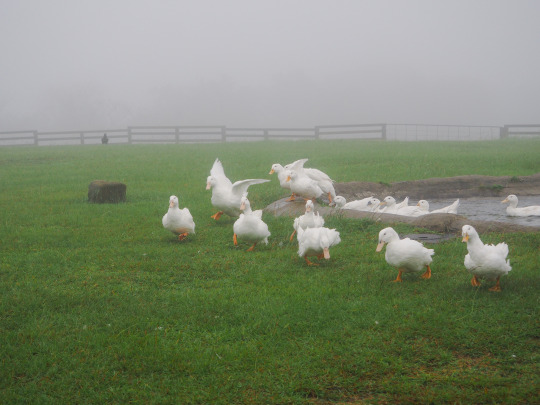
I really love the combination of green hills, mountains and thick fog. It's something that makes me happy.
#japan#my photo#japanese#nature#cottagecore#original photographers#cozy#fog#cottage#cottage aesthetic#cotagecore#animals#farm#farmcore#forest#nature photopragpy#original photography on tumblr#original photo
511 notes
·
View notes
Text
Happy IKEA monkey day to all those who celebrate


December 11, 2012 was the day Darwin the Japanese macaque was found roaming outside an IKEA in North York, Toronto. He was rescued by Storybook Farm Sanctuary and lives there to this day enjoying the good life with many monkey friends.
#ikea monkey#darwin the macaque#monkeys#japanese macaque#macaques#storybook farm sanctuary#animal sanctuary#animals#cute#fun fact#primates
410 notes
·
View notes
Note
Gin x Farmer would be a perfect match!! They both have that chill comforting vibe

call that shit double cuntry boy action
#korean japanese solidarity??!! SLASH H JAY AGHGHAAHHA#anyway tghis is. like the nicest thing ive drawn in a while. at 3 am nonetheless#undertale#sans#gin sans#farm sans#farmtale sans#farmgin#(????????? yueah okay lets go with that)#kia doodles shit#Anonymous
491 notes
·
View notes
Text
theres a post that floats around every so often thats something like "trying to make dnd into a new thing is like wanting to mod skyrim into a cabbage farming simulator" and bold of you to think i DONT do that. skyrim can be anything.
#its a dating simulator#its a shooter#its a jrpg if you set the language to japanese#its a madden iteration#its a puzzle game#and it is in fact a cabbage farming simulator
74 notes
·
View notes
Text

Kasamatsu Shiro
Rice Planting
1953
#kasamatsu shiro#rice planting#rice growing#asian art#woodcut#japanese woodblock print#japanese prints#farming#japan#japanese art#art history#tumblrstyle#tumblr art#tumblrpictures#tumblrpic#tumblraesthetic#aesthetictumblr#tumblrposts#tumblrlove
117 notes
·
View notes
Text
less than 4 minutes into Pom Poko and, i don't get Isao Takahata, he refuses to draw nipples on characters or characters without mouth muscles but he'll draw balls on raccoons, i don't get it. i don't get it, what the fuck are this man's priorities.
#james talks#james watches stuff#pom poko#studio ghibli#isao takahata#when i say he here i obviously don't mean him literally i know there are other people drawing it but obviously he has final say over stuff—#bc he's the director#anyway hopefully there's no people in this so i don't have to see his ugly human designs again#but anyway the movie is fun so far#finding subs for this that matched was a nightmare#the inbuilt subs said the raccoons lived in the 'woods' but in the actual Japanese dialogue they clearly said 'mountain'#& it took far too much fiddling and looking to find something that matched and actually had all the subs (including text) instead of just—#the dialogue and stuff. and even in this the translations of certain lines changes a lot (like saying the racoons always lived near a farm)#so i am forced to watch with 2 subtitles at the same time and draw a conclusion on each line of dialogue to see what the actual line is#so if i miss something that's my bad but like subtitlers should simply agree on what's being said.#this is kinda why i'm a big proponent of direct translation with explanations in brackets for cultural contexts
15 notes
·
View notes
Photo

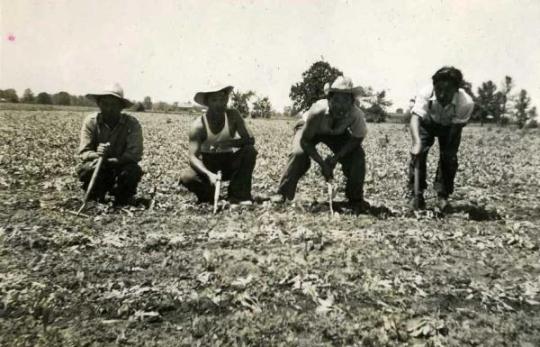
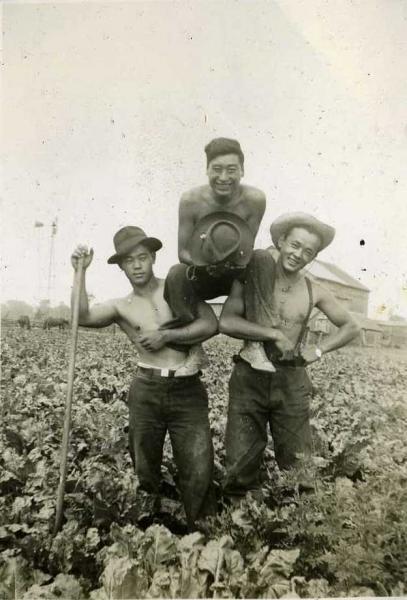

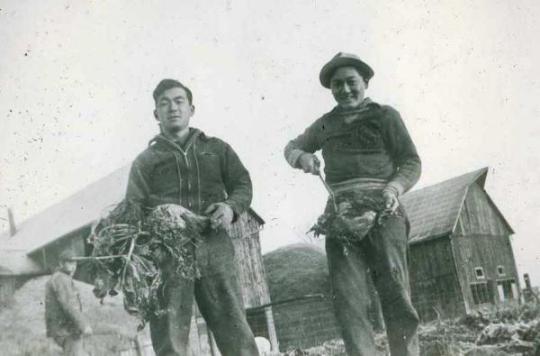
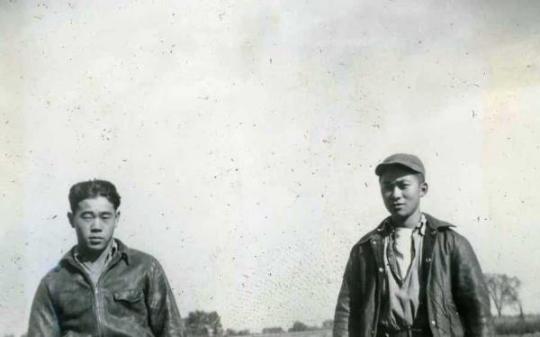
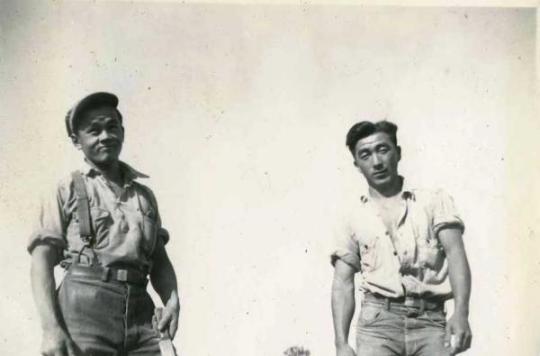
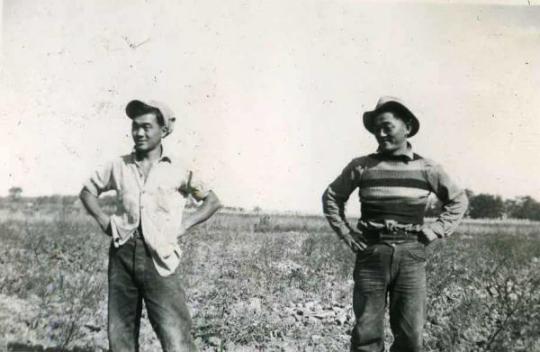
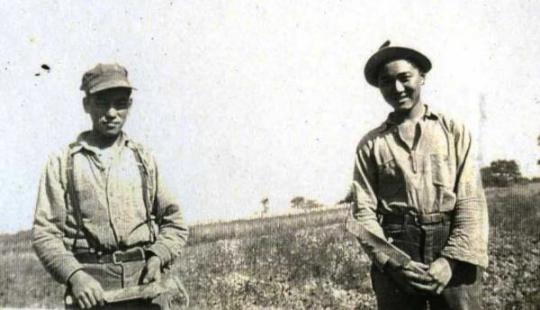
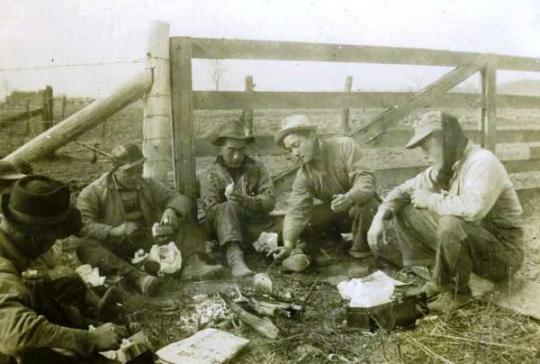
Photographs taken by Yon Shimizu, a Japanese-Canadian who was exiled from the west coast of Canada to Ontario during the second World War, along with hundreds of other Japanese-Canadian men. In 1942, he worked along with several dozen other men as a farm labourer with the Ontario Farm Service Force near Glencoe, equidistant from Sarnia, London and Chatham. These are photographs he took of the sugarbeet harvest, and were digitized from a DVD of Yon Shimizu’s scrapbook by the Southwestern Ontario Digital Archive. All dated 1942 though they definitely show a range of time during that summer and fall - final harvesting of sugarbeets is in late October or November, and the last photo shows the men huddling from the cold in November.
1) At Glencoe train station; the ‘49′ Gang, according to the caption. Left to right: Tsutomu "Stum" Shimizu, E. Ono, T. Okamoto, T. Kuwabara.
2) Blocking 48 Gang, that is, thinning or "blocking" the sugar beets; left to right: S. Miyashita, Y. Madokoro, S. Kawahara, J. Henmi.
3) “He-Men.” Left to right: B. Hoita, K. Goto, T. Hoita.
4) “Siesta Time!” T. Okamoto taking a siesta during the beet harvest.
5) “Block Busters!” Showing off some huge sugarbeets during the thinning (blocking) process.
6) Gang 5 "Toppers A-1" Butch Hoita and Stum Shimizu.
7) Gang 5 "Toppers A-1" Tommy Hoita and Tomo Okamoto.
8) Gang 5 "Toppers A-1" Stum Okamoto and Esao Ono.
9) Gang 5 "Toppers A-1" Tom Kuwabara and Yon Shimizu. Toppers defoliate the beets as close to harvesting as possible.
10) Lunch, Cold November Day
#japanese canadian internment#internment camps#japanese canadians#canadian history#farm camp#nikkei#nikkei kanadajin#canada during world war 2#dictatorship within democracy#relocation camp#defence of canada regulations#glencoe#kent county#chatham#london ontario#racism in canada#black and white photography#archival photography
84 notes
·
View notes
Text

teriyaki chicken and broccoli with a side of the hyprice!!!!!
the hyprice i think is just yokohama walker coded to me at this point lol but hella awesome banquet also played in my head so bat mochis came to say hey lmao
#this is vee speaking#i was watching pokemon content so i previously had pkmn music stuck in my head#but then i started cooking and those two songs overtook the music of my childhood INSTANTLY lol so ik it’s real#so my rice might be bat biased and based lol#ik that one of the rice farmers is a bat stan#(and he’s so funny too he’ll ride with the bat seiyuu on the farm but he’s never with any other seiyuu and meeeeee LOL)#so maybe that’s why mine feels bat powered this time LOL#but still ridiculously tasty my god lol like i’m not japanese have only spent a little over two weeks out of my life in total in jp#but this rice just envokes the feeling of home lmao
18 notes
·
View notes
Text
Quadratum Underclassmen Drama
Xehanort: Did the weeks spent farming heartless for exp mean nothing to you?!
Bragi who was bodynapped and died way before: Sir this is a 7/11.
#khdr spoilers#kh dark road#kingdom hearts#kingdom hearts dark road#Luxu picking something else right next to them sweating bullets and shivering from the memories#I'm farming on two dr profiles because obviously I don't have ff14 to waste time on rn#well and because I'm petty and don't want to abandon all the progress I made on my japanese account#quadratum
16 notes
·
View notes
Text
Anonymous asked: I enjoy your tumblr tremendously. You manifest an appreciation, perhaps passion, for Scotch Whiskey. Firstly, do you consider fine Japanese or Australian whiskey equally good? Secondly, do you also enjoy Armagnac and Cognac? Personally, I find the former often overlooked and, generally, better value. What do you think? Thanks!
I’m very much a wine drinker these days and being a co-owner of a French vineyard has made me more immersive in that world of appreciating fine wines, its traditions passed down from generation to generation on wine making, social customs that are the fabric of particular way of living and enjoying life. By the very act of drinking the wine you are being a part of the terroir (a hard word to define but generally meaning ‘of the soil’) of where the wine was made.

There are a lot of similar reasons to drink whisky of which I used to drink a lot, especially when I was an army officer and drinking games in the officers mess was the done thing. But these days I drink in extreme moderation and often with a well deserved cigar. Some people like the way it makes them feel fuzzy and warm, when laughing comes a little easier. Maybe it takes the edge off a long day or helps hype the anticipation for what might be a long night. For me, the reasons why I love whisky are much more than that.
Like wine, whisky tells us a story. In my case a Scottish story as one side of my family have strong roots in that part of the world, and are still thriving there. It tells a story of a certain time and a certain place, of a distillery and those who work in it. I love the idea that an entire team of people worked every day to grow barley, distill whisky, maintain a distillery, patiently watch over barrels, and the million other minute tasks that go into creating a single bottle of whisky that is then transported locally and all over the world for me to enjoy. And when I’m holding a 20 year old Aberfeldy single malt in a Glencairn glass on the other side of the world, I can take one sip and feel myself transported all the way back to the central Highlands.

And it tells a story on an individual level, too. What inspired me to buy the bottle and where I got it. Maybe it starts with how I learned about it or where I first tried it and weaves until here and now, to who I’m drinking it with and when. So when I sip on any Dalmore whisky I sometimes think of meeting Dalmore’s master distiller, Richard Paterson, who wowed me with his infectious love of his craft and old school bonhomie as he led a sampling some of Dalmore’s finest single malts at the distillery.
Like wine, whisky is a life time journey of discovery from following the aromas and flavours of each dram. From the Scottish Lowlands where whiskies are often light bodied, delicate, soft, smooth, and have very little peat, and they’re malty and citrusy with flavours of grass, honeysuckle, cream, ginger, toffee, toast and cinnamon; to the Scottish Highlands where whiskies are full bodied and spicy whiskies, lighter and fruity whiskies and those that are full bodied, peaty with a salty tang from the sea. From Speyside where its famed single malts are both light and bold whiskies that are sweet, fruity and spicy with hints of apple, nutmeg, vanilla and smoke; to Islay where the famed Scotch can be peaty, smoky, earthy and oily with a hint of salty sea air, brine and seaweed. Whiskies then need to be explored and as one becomes more skilled at detecting aromas and flavours; and as one tries more whiskies, one finds more aromas, flavours, and even more whiskies that tantalise the palate.
Which is why I’m not particularly tribal about whisky.

I wish I could compare Japanese and Australian whisky and give you my opinion if they are equally good. But I can’t. My knowledge and experience of drinking Australian whisky is dire compared to how much I’ve enjoyed Japanese whisky over the years. I’ve been to Australia on a few occasions and I’ve even gone on a few wine trails to widen my knowledge of the Australian wine making industry and learn lessons from them for our own wine making back in France. But on the side I did sample some its home grown whiskies.
I recently had a tipple of the Starward Two Fold, given to me by an Aussie work colleague and I tried it more out of curiosity than any real knowledge. The one I had had spent time in Aussie shiraz and pinot noir wine barrels before it was bottled, making for a blend of spicy and caramel notes. Apparently it won five gold medals at the World Whiskies Masters (2022). Hailing from Victoria’s New World Whisky Distillery, Starward have been favoured by many for their innovative approach to modern whisky production, eschewing the traditions that bind so many other distillers and producing consistently interesting whisky. Their whiskies are all made from Australian barley, aged in Australian barrels and reflect the terroir with subtlety. And then finished in Australian wine casks. I think it’s an excellent entry point into Australian whisky and at a decent price too.
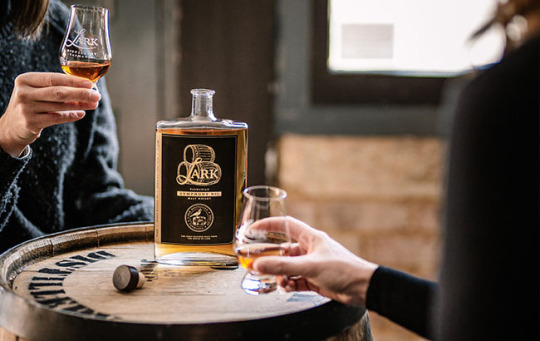
I’ve had the Lark’s Classic Single Malt with its hints of citrus and butterscotch and it’s peated too with a lovely balanced smoky woodiness and vanilla. Also from the Lark’s stable I’ve had tipple of Lark 9 year old Bourbon cask whisky which has a lot more complex notes. Lark of course is at forefront of Tasmania’s whisky growing region with other whiskies such as Sullivan’s Cove and Bakery Hill, also adding to the growing prestige of whiskies made in Tasmania.
I love the story of how Lark began. Apparently, founder Bill Lark was trout fishing with his father-in-law Max in the Tassie highlands that the two scratched their heads and said: “I wonder why there isn’t anyone making malt whisky in Tasmania.” The climate, access to barley, natural peat bogs and pure, soft water were all in abundance, but nobody had connected the dots for over a hundred years due to archaic licensing laws. Since then, Bill Lark worked tirelessly to promote the Southern island as one of the world’s best whisky-producing regions, all the while expanding his eponymous distillery from a small apparatus in his kitchen to a huge copper still which gets put through its paces to keep up with demand. Apparently, the operation is still a family affair and the distillery itself has undergone a recent world-class makeover. Now that’s a story to worth raising your dram to.

Of course Australian whisky is still startlingly a niche thing, even within Australia, with Starward its leading domestic producer accounting for 66% of Australian whiskies 1% share of the market. What I understand from Aussie work colleagues who are whisky aficionados is that 50% of the Australian whisky market has been bourbon. Jack Daniels accounts for over a quarter of the market with 26% and it accounts for 52% of American whiskies sold in Australia. Jim Beam has a respectable 10% and 20% across those sectors, and Makers Mark is third. Rye whisky accounts for just 0.72% of the total sales, with Woodford Reserve (34%), Bulleit (32%) and Michters (11%) the leaders.
Scotland holds 27% of the total market - blends and malts. Johnnie Walker dominates with 15%. Chivas Regal represents 2% of total sales. Glenfiddich 12-Year-Old Single Malt leads the Single Malts (Scotland) category with 1.7% (6% of total Scotch, including blends). Lagavulin, Laphroaig and Talisker all equate to around 1% each. Given that these are relatively small and distant distilleries, it does suggest that the smoky/peaty style from Islay is beloved by malt drinkers in Australia.
Japan comes in with 1.5%, with Hibiki dominating - their 12-Year-Old has 25% of the market and their 17-Year-Old has 30%.
It would seem that the era of Covid, closures, cuts and chaos is proving to be an exciting time for whisky in Australia. The story seems to be Australian whisky is enjoying dynamic growth. The growing demand through volume for Australian whisky is primarily in Asia. Australian producers are now entering partnerships with specialist whisky markets like Japan and Taiwan which has seen an incredible uplift on single cask requirements (cask strength, finishes, aged statements).
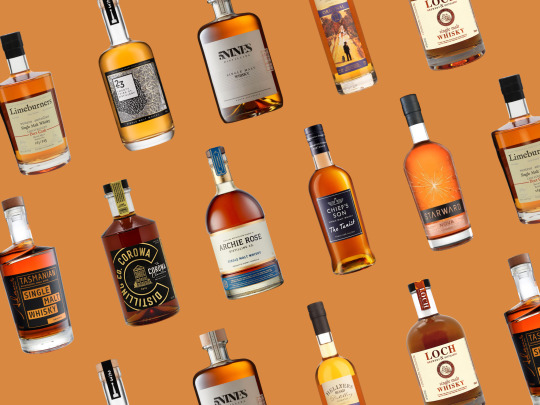
Australian Distillers Association figures reflect this growth. The number of registered Australian distilleries almost doubles from 2021-2022, growing from 200 in January 2021 to 380 in February 2022. There is no question that Australia could be the next break out whisky nation once prices become more competitive to other foreign producers and it has greater market visibility outside of Australia. Just as importantly the whisky market is young. The number of 25-34 year olds drinking whisky has doubled in the past six years and around 19 million glasses of whisky are drink every month.
What it also has going for it is the land’s natural resources ie the earth (or the terroir as the French winemakers call it). Australia is one of the largest malting-grade barley producers in the world, with many varieties unique to the country. Whisky producers increasingly work more closely with a number of New South Wales’ farmers to get hold of unique malts which demonstrate regional terroir. It allows all concerned to develop a relationship with the land and their custodians, exploring ancient and heirloom varieties. Surely, that’s a good thing.
It also allows for these whisky producers to experiment and take creative risks both in the way they can source the variety of grains and also explore ‘paddock to bottle’ with barley. The end result is Australian whisky can frustrate anyone to categorise it into easy tick boxes. That’s a good thing too.

Finally, it would be remiss to talk about Australia’s natural resources without alluding to its vineyards. The country’s winemaking history has granted distillers access to some truly fantastic ex-fortified wine casks, particularly Apera. Australia’s answer to sherry, Apera, is made from a different blend of grapes, but still has many similarities in style. Many of these casks have been around for decades - indeed, whisky producer Archie Rose has filled casks that contained Apera for more than 70 years.
Australia can learn from Japan’s experience of whisky, namely, concentrate on producing great whisky for the world to enjoy and most importantly, take your time.
I know a lot more about Japanese whisky as I grew up partly in that culture as a child when we lived overseas but also been a frequent visitor there for work reasons. I think a good explanation for why Japanese whisky is so good is that Japan’s distilleries typically adhere to Scotch methods, but the country’s distinct seasons have a significant impact on the maturation process - the cold winters slow the ageing of the spirit, while the humid summers speed it up. A variety of casks are used in the ageing process, but the country’s indigenous lumber, most famously mizunara (Japanese oak), ages unique whisky that’s subtle, yet strong. Unlike their Scottish counterparts, Suntory and Nikka, the two giants of Japanese whisky, distil a mind-boggling array of whiskies in-house, giving them great control over their products and enabling them to experiment with different whisky-making techniques.

The history of Japanese whisky is shrouded in mystery, since very little is recorded in whisky making before the famed establishment of Suntory’s Yamazaki Distillery in the early 20th century. What we do know is that a few shochu and sake breweries produced Japanese whisky on the side as early as the 1850s. Whisky took a historical turn in Japan in 1923, when Suntory established the first official whisky distillery. But it was when Suntory’s domestic market for whisky collapsed and it and other rival producers such as Nikka focused on producing the best single malt whiskies it could did Japanese whisky gain global recognition with countless international awards and has been in high demand from whisky lovers everywhere.

Today, the companies of Masataka Taketsuru (Nikki) and Shinjiro Torii (Suntory) still represent their founders’ passion for Japanese whisky. Masataka Taketsuru was known as the “Father of Japanese Whisky” and studied the intricate whisky-making process in Scotland. He took his knowledge and his newly wed Scottish wife, Rita, back to Japan and established one of the most popular Japanese Whisky companies: Nikka Whisky. Shinjiro Torii was the founder of Suntory, known as Kotobukiya back then, and built Yamazaki in 1923. However, Taketsuru and Torii had a history before these two companies were born. Taketsuru actually worked in Torii’s company for over 10 years, so the Suntory and Nikka whisky companies have a background story that is linked to each other. Taketsuru came from a family who had a sake brewery for Japanese alcoholic beverages. He studied chemistry at the University of Glasgow to improve his understanding of creating alcoholic beverages.

Taketsuru and Torii became business partners. But their search to find a whisky that the Japanese people could like and claim as their own came to nought. Torri, the business brains, wanted the distillery to be near as possible to Tokyo and have billboards plastered at key points where trains would go by. Taketsuru, the perfectionist, wanted to move further north to produce whisky as he was convinced the climate and soil up there would be more conducive to great whisky. Eventually they went their separate ways. Taketsuru ventured out on his own in 1934 and established the Yoichi Distillery in Hokkaido in 1940.
Suntory originally offered an alcoholic beverage called Akadama Sweet Wine, which was a huge success for the company and continues to be produced today. However, Shinjiro Torii wanted to create a whisky that suited the Japanese people’s preferences and moved forward with the establishment of Yamazaki Distillery, despite the opposition he received from his business partners. In 1929, Torii created the first whisky from Suntory called Suntory Shirofuda (‘White Label’), but it turned out to be unsuccessful because it didn’t fit the tastes of the Japanese consumer base. The second whisky released from Suntory was the Suntory Kakubin, which became a hit and continues to be Japan’s #1 best-selling whisky.
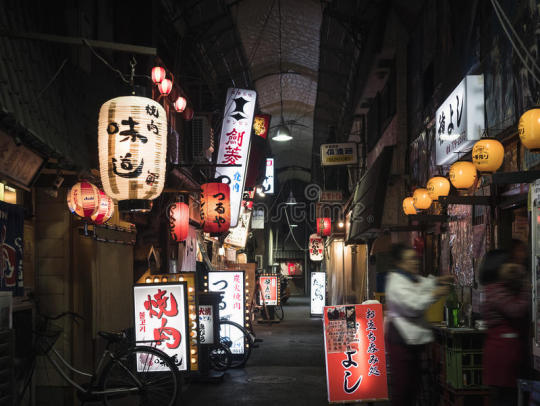
To spread the knowledge and passion for Japanese whisky, Suntory opened whisky bars around the country in 1955. In 1970, Suntory revolutionised how the Japanese food and drinking culture by creating the “Mizuwari,” a water-and-whisky drink that was easy to drink and enjoy with Japanese cuisine.
However domestic whisky market began to collapse for not just Suntory but other domestic whisky producers in the 1990s. The culture was changing. No longer were young salaried men drinking whisky as their bosses did - it was seen as a rite of passage. They instead preferred vodka and other spirits now making inroads into the Japanese drinks market. Increasingly whisky came to be seen as ‘an old man’s drink’. Sales plateaued and Suntory focused on other parts of their drinks and food empire. Suntory, along with Nikka, began to focus on producing high end single malt whiskies that could makes its debut to the outside world. This only bore fruit a decade later in the 2000s when Japanese whisky started to winning prestigious awards for its whiskies.

It’s an open question whether the rise of Japanese whisky was also due to the product placement of tis whisky in the cult movie ‘Lost in Translation’ in 2003 which featured Bill Murray’s character advertising Suntory’s whisky with the memorable quote: “For relaxing times, make it Suntory time!” Some have argued that the movie helped in boosting the exposure of Japanese whisky as international whisky lovers gradually discovered this luxury spirit from Japan. At the very least, the Hollywood exposure it didn’t hurt. In 2003, Suntory’s Yamazaki 12 Year Old won the Gold Award at the International Spirits Challenge in the UK and it was part of a wave of outstanding awards for Japanese whiskies.
Oddly enough, whisky is back in favour with the Japanese. In more recent years, the Japanese whisky business has boomed and become even more popular within Japan and out of the country. The Highball drink, a simple mixture of Japanese whisky and soda, has become a staple to drink with Japanese dishes.
Suntory's Yamazaki 12 Year Old continues to impress with its well-balanced fruity sweetness, something that appeals to novice and experienced whisky drinkers alike. I would say it’s the original Japanese whisky and remains Suntory’s flagship single malt. Yamazaki is multi-layered with the aromas of fruit and Mizunara Oak. Even today, Yamazaki is the leading single malt whisky sold in Japan, and enjoyed in more than 35 countries. It’s an excellent entry point into Japanese whisky.
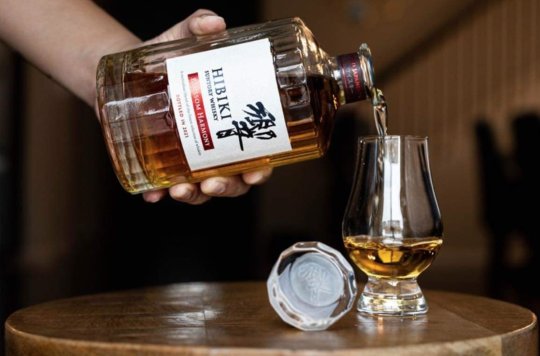
I would also recommend the Hibiki Blossom Harmony. Blending is a key component of the craft of making Japanese whisky. Great care and attention is paid to flavours and proportions, with some distilleries producing dozens of different whiskies that are combined into the final product. Hibiki, a blend from Suntory, launched in 1989, and there are now several different expressions in the range. The 17-year-old version is probably the best, an incredibly well-rounded sipper with lovely notes of orange peel, caramel, and toffee.
As for armagnac and cognac, I would agree with you that generally the former is overlooked when actually it is better (my opinion). It is the only spirit that can really become more refined with age. Before I moved to France and before I decided to invest in a vineyard with my cousins, I was quite happy drinking cognac as an after dinner drink - to go with my cigar that I smoked with the men. I wasn’t really aware of armagnac until I saw it increasingly being served around the French dinner table. I enjoyed the experience and it set me off on a little side journey of exploration.
I hadn’t realised that it was France’s oldest brandy for over 700 years but talk to locals and they derisive of calling armagnac a brandy. It’s closer to wine. The production of Armagnac has been documented since 1310, when Vital Dufour, prior of the town of Eauze, described in his ‘Livre très utile pour garder la santé et rester en bonne forme’ the advantages of a brandy known as aygue ardente. Armagnac appeared thanks to the meeting of two civilisations: that of the Arab world and its still, and that of the Christian world and its monks who planted vines. It does not yet bear the name of today. It was then an apothecary’s remedy. In 1461 it was found on the market of Saint Sever. It became a drink that was appreciated for its gustatory qualities, a drink called “le merveilleux”. Historically, Armagnac is a precious brandy, but confined in the margin of the wine production of the region.

As you well know Armagnac is produced in the South-West region of France, the Gers department, the East of the Landes, and the South of the Lot-et-Garonne; whereas Cognac is produced 300 km further North in Charente, Charente-Maritime, parts of the Dordogne and Deux-Sèvres - where it so happens a lot of British expatriates reside permanently or have a second home.
The terroirs are distinguished by their soils and climate, which give their brandy their typical character. The Cognac soil is mainly limestone, while the Armagnac soil is sandy, clayey-siliceous and clayey-limestone. The Armagnac region has a continental climate, while the Cognac region has a more oceanic climate. Part of the reason why I was drawn to armagnac was variety of grapes used. You know that cognac is made from the Ugni Blanc grape only, whereas Armagnac is made from 10 different grape varieties, including Ugni Blanc. The diversity of grape varieties authorised by the AOC Armagnac decree is due to the viticultural tradition of the region which also produces tasting wines. The Cognac region only produces wine for distillation.
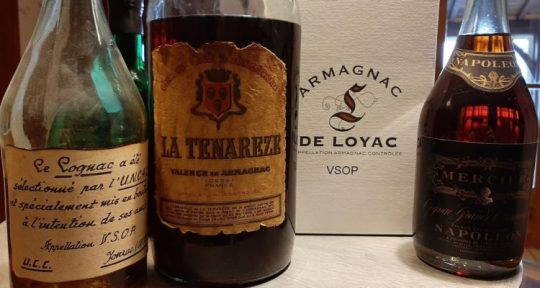
Where the full flavour of armagnac comes out above cognac is how they are made. Armagnac is column-distilled, which is a process where the alcohol is continuously heated between two vertical columns and then aged in French oak barrels or casks for a minimum of 1 year. Though Armagnac and Cognac are both are brandies distilled from wine, Armagnac is distilled once while Cognac is distilled twice. Indeed the still used for the distillation of Cognac is different from the one used for Armagnac. The Cognac or “Charentais” alembic is a basic copper alembic c” (double heating): the alcohol is distilled twice and the brandy comes out with a higher alcohol content (72°). The Armagnac still is a double-column copper still with trays, for a continuous distillation: the wine is distilled only once and the brandy comes out with a low alcohol content (54°).
The plates of the Armagnac still allow the alcohol vapours to bathe in the fresh wine and extract its aromas: this is the bubbling. This step does not exist in the Cognac still where the alcohol vapours do not meet the fresh wine. Its ageing links it to the culture of wine and distinguishes it from other brandies. Like wine, Armagnac can be vintage to reflect the history of the year. Cognac is gradually diluted with distilled water to reach its 40-45° for sale. The brandy, “burned” by the alcohol, cannot evolve.
To my mind, armagnac and cognac have two singular historical trajectories, which influence their current reputation. Armagnac has developed on a French consumption model. Its more confidential artisanal production perpetuates ancestral know-how. Cognac was conceived for an export market to the Netherlands and England. It mirrors the story of the battle between Bordeaux wines and Burgundy (or Bourgogne) wines. Bordeaux wines were made from a blend of grapes and produced for an export market to the English primarily whilst Bourgogne has been a single grape and very much towards a home grown market.

If I have any visitors to France I always introduce them to armagnac if I can. Armagnacs exalt the richness of that South West region’s gastronomy: foie gras, chicken in a pot, duck breast. They go particularly well with dark chocolate cake, almonds and dried fruits, walnut pie or orange macaroons.
It’s great as an after dinner liqueur. The sweet flavours of Armagnac make it a perfect after-dinner drink. I would also choose an older armagnac as a rule older is always better so go with a vintage armagnac. But not always as when drinking clear Armagnacs - known as Armagnac blancs or Haut-Armagnacs - which have spent less time in the oak ageing barrels - one can enjoy them on the rocks or chilled in the fridge. I particularly love to end a meal at a restaurant having an Armagnac Brûlot - in other words, flambé, using sugar to set it on fire. It’s a great way to end a pleasant dining experience.
But armagnacs are also perfect for cocktails as a pre-dinner aperitif or lounging around a swanky hotel bar. I would highly recommend the Armagnac Stinger, a cocktail, originally served with Cognac, was a pre-Prohibition American favourite. It combines Armagnac, crème de menthe, orange bitters, and garnish with a sprig of mint. There is also the D’Artagnan, which combines armagnac, orange liqueur, orange juice, simple syrup, and finished off with a splash of champagne - perfect for partying. The Continental Sour is another cool one which mixes together armagnac, egg whites, simple syrup, lemon juice, and red wine.
Whatever one drinks, be it armagnac or cognac, I believe in its conviviality for cultured conversation and good natured laughter (at your own expense) over a shared meal with like minded people, be they family and friends. The French love arguing over a fine meal. The arguments can be heated and robust but they are never personal and drink is the balm to bring people together again. If you bear that in mind then you can’t go wrong.

Thanks for your question.
#question#ask#drink#drinking#alcohol#scotch whisky#whisky#japanese#australian#aqua vita#armagnac#cognac#french#france#farming#wine#culture#personal
41 notes
·
View notes
Photo

New cute vegetable faming village assets! 🍂
#digital art#Digital Illustration#digital drawing#farming#video games#indie games#game screenshots#game art#japanese#japanese village#japanese market#farmers market#vegetable market#japanese style#game assets#indie game#original art#original content#original drawing#lantern#autumn#city builder#tile set#isometric
30 notes
·
View notes
Text

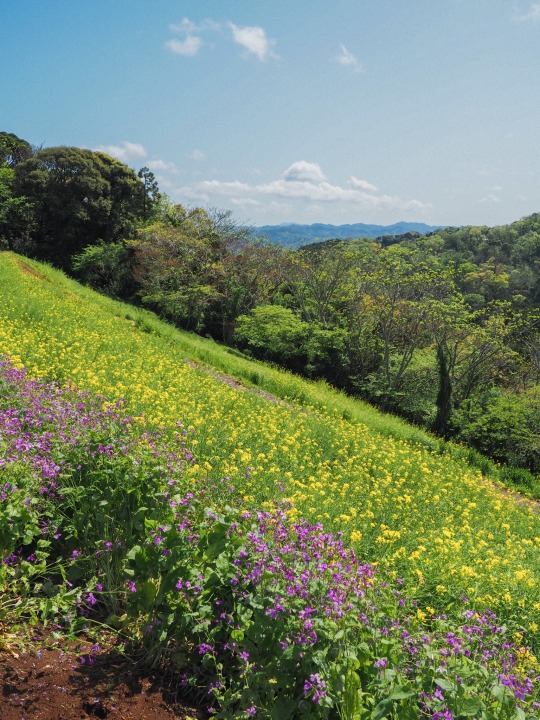
#cottagecore#japan#flower#fairycore#cozy#japanese#goblincore#nature#fairy#no anxiety#flowers#farm#nature lover#meadow#cottage garden#cottage#life#keep calm#original photographers#photographers on tumblr#artists on tumblr#farmcore
164 notes
·
View notes
Text
Japanese Family Home.☁️
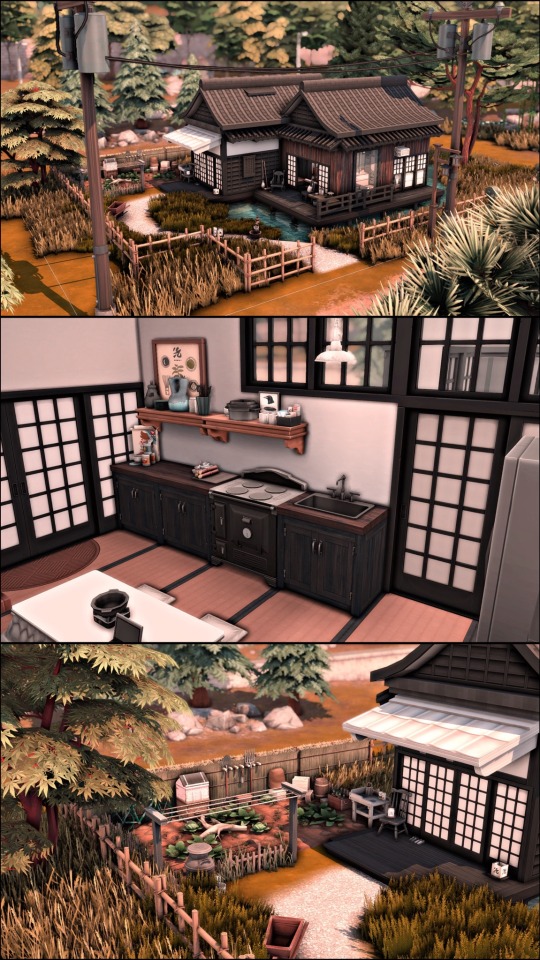
Hello! This time i've made a Japanese Inspired Family Home in Mt. Komorebi. It's a perfect Countryside Farm House for a family. It has a cosy and calm vibe. I hope you like it!
☁️No CC.🎈
Stop Motion Speed build: https://m.youtube.com/watch?v=vMR-3cA_dSE&pp=ygUKS2VsbHloYXJ0eA%3D%3D
youtube
Social’s:
| Youtube: Kellyhartx
| Instagram: Kqhartx
| TikTok: Kellyhartx
| Twitter: Kqhartx
| Partreon: Kqhartx
| Reddit: Kellyhartx
Trayfiles: https://www.patreon.com/posts/japanese-family-101820644
#sims 4#sims 4 build#sims 4 builder#the sims 4 building#the sims 4 no cc#thesims4#the sims 4#the sims 4 build#youtube#the sims 4 japanese family home#the sims 4 japanese farm#the sims 4 japanese countryside
6 notes
·
View notes
Text
On April 4, 2008, A Page of Madness was screened at the Nippon Connection Film Festival.

#a page of madness#teinosuke kinugasa#silent film#horror#horror movies#horror film#horror art#art film#experimental film#japanese horror#rediscovered film#avant garde#avant garde film#avant garde horror#movie art#art#drawing#movie history#pop art#modern art#pop surrealism#cult movies#portrait#cult film#animal farm
2 notes
·
View notes